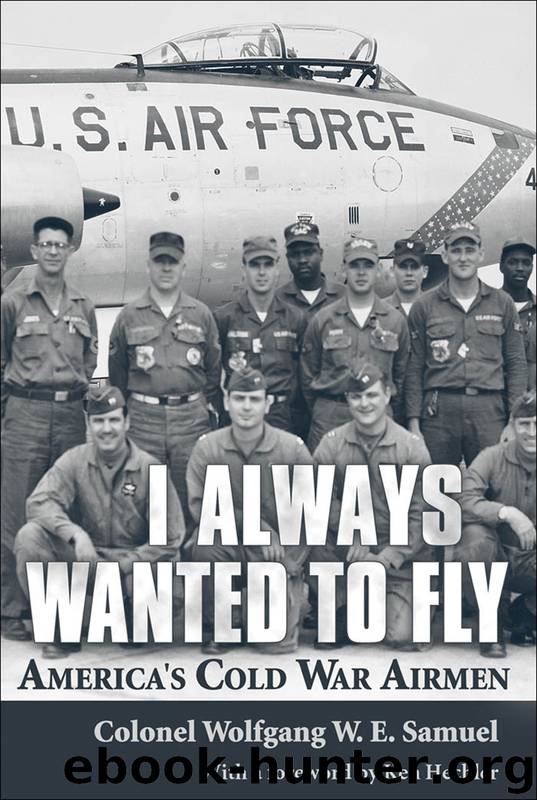I Always Wanted to Fly by Wolfgang W. E. Samuel

Author:Wolfgang W. E. Samuel
Language: eng
Format: epub
Publisher: University Press of Mississippi
Published: 2001-03-24T16:00:00+00:00
American and British RB-45C air crew and technicians, RAF Sculthorpe, 1952. Sam Myers is front right. H. Myers.
Hack Mixson explained that “we rotated the three 91st Wing squadrons into Sculthorpe. Because of my experience with the RAF crews and as the only one knowledgeable of the real purpose of their being there, I remained behind in England when my squadron rotated home. All in all, I got to do about four three-month TDYs over there.”
Meanwhile, plans were made for the first deep penetration of the Soviet Union. Four RB-45s at Sculthorpe were stripped of their U.S. Air Force markings and repainted with Royal Air Force roundels on the fuselage and RAF colors on the tail fin. Aircraft numbers were omitted. On March 21, 1952, a night mission was flown into East Germany, east of Berlin, to find out how the Soviets would react to such an incursion. Their reaction wasn’t sufficient to dissuade the planners from going ahead with the overflight they had planned for the night of April 17, 1952. In a 1998 letter to the Air Force Museum at Wright-Patterson Air Force Base, Squadron Leader John Crampton recalled, “Even though the story leaked out of the woodwork two or three years ago, I still find it strange to talk and write about it. While it was happening it rivalled the Manhattan Project for secrecy. In fact, I think it outranked the Manhattan Project. While off base we weren’t allowed to THINK about it. It was all well above top secret. It was at Sculthorpe that Hal Connor, the tough little Texan who commanded the squadron, selected four of his airplanes (one was a spare) for our operational use.” Hal Connor was the commander of the 322d squadron, to which Sam Myers was assigned and which pulled a rotational tour of duty at Sculthorpe. Connor, however, was not aware of what the RAF was up to; Hack Mixson and a handful of highly placed military and political officials were the only Americans who knew that.
On the night of April 17, 1952, three RB-45Cs in RAF colors rose into the East Anglia sky and proceeded to their individual air-refueling areas—one over the North Sea; another over Copenhagen, Denmark; and a third south of Frankfurt, Germany. The three aircraft topped off their fuel tanks from U.S. Air Force KB-29 refueling tankers and proceeded on their individual routes, flying at thirty-five thousand feet in total radio silence into the heart of the Soviet Union. One plane photographed targets in the Baltic states of Estonia, Latvia, and Lithuania; in Poland; and in the former German province of East Prussia. The second aircraft flew across Belorussia as far as Orel. The third plane was piloted by Squadron Leader Crampton, with Sanders as his radar navigator. This craft flew the longest and most southern route, crossing the Ukraine and penetrating as far as Rostov on the Black Sea. Each route had frequent turning points to include a maximum number of potential targets.
A month after the
Download
This site does not store any files on its server. We only index and link to content provided by other sites. Please contact the content providers to delete copyright contents if any and email us, we'll remove relevant links or contents immediately.
| Africa | Asia |
| Canadian | Europe |
| Holocaust | Latin America |
| Middle East | United States |
Fanny Burney by Claire Harman(26528)
Empire of the Sikhs by Patwant Singh(22975)
Out of India by Michael Foss(16791)
Leonardo da Vinci by Walter Isaacson(13188)
Small Great Things by Jodi Picoult(7020)
The Six Wives Of Henry VIII (WOMEN IN HISTORY) by Fraser Antonia(5397)
The Wind in My Hair by Masih Alinejad(5034)
A Higher Loyalty: Truth, Lies, and Leadership by James Comey(4846)
The Lonely City by Olivia Laing(4750)
The Crown by Robert Lacey(4724)
Millionaire: The Philanderer, Gambler, and Duelist Who Invented Modern Finance by Janet Gleeson(4381)
The Iron Duke by The Iron Duke(4293)
Papillon (English) by Henri Charrière(4199)
Sticky Fingers by Joe Hagan(4103)
Joan of Arc by Mary Gordon(4016)
Alive: The Story of the Andes Survivors by Piers Paul Read(3970)
Stalin by Stephen Kotkin(3879)
Aleister Crowley: The Biography by Tobias Churton(3589)
Ants Among Elephants by Sujatha Gidla(3417)
